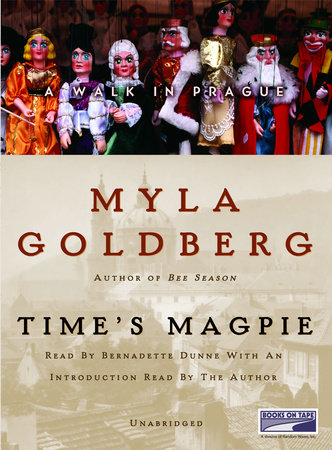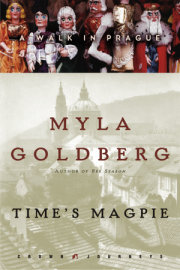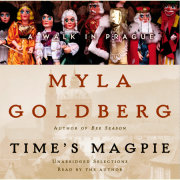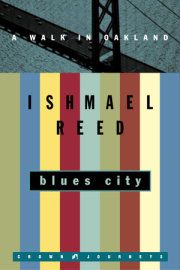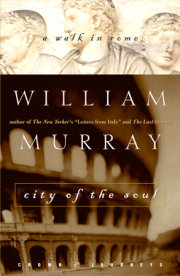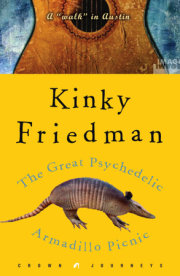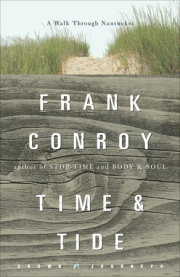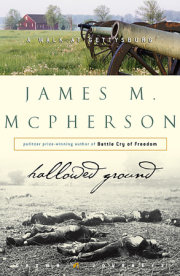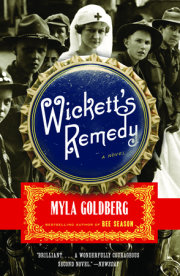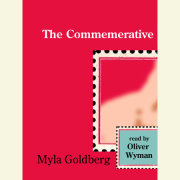Forget the long days. When the days are long, bands of Germans and Italians and Japanese and British mob the narrow streets of Old Town, and herds of American college students in velvet jester hats and prague drinking team T-shirts stampede across the Charles Bridge singing Pearl Jam songs. But in March or April, the worst of winter is over and the tourist hordes have yet to descend; by early September the summer crowds have dispersed. On the edge of a season it is still possible to duck onto a narrow, cobbled side street to find it deserted and to feel time straddling centuries the way Prague straddles its river. So many of Europe's cities have been bombed and burnt and torn down and rebuilt again that their physical history survives in stray fragments or not at all, but Prague is time's magpie, hoarding beautiful, eclectic bits from each successive era. In Prague, Gothic towers neighbor eleventh-century courtyards, which lead to Baroque and Renaissance houses with twentieth-century bullets embedded in their walls. Art Nouveau hotels abut formerly socialist department stores that now sell French perfume and American sneakers. Through a combination of luck, circumstance, and obstinance, Prague has stockpiled ten centuries of history.
The city's unrelenting profusion of stimuli forces the brain to screen things out, until one day a new sort of detail will ambush an unconscious filter and then appear everywhere, remaking once-familiar streets. Almost every city block displays a plaque commemorating Prague's countless martyrs from across the centuries--resistance fighters and outspoken nationalists, religious heroes and fallen soldiers. Usually these plaques are placed over doorways, or just above eye level on a building's edge. Small and made of dark, weathered metal, they are easily overlooked but upon noticing one the rest appear, Prague's long, sad memory emerging with each additional step. It becomes impossible to go anywhere without noticing more names; Prague becomes a city overrun by death. Then, the eye will be diverted from the funereal by an ornamental frog decorating a doorway, or a marble frieze of a violinist fronting an apartment building that was a music school a century before. It becomes apparent that almost every building is charmingly adorned--even in the shabbier neighborhoods lion heads roar above doorways or cherubs recline below windows. The memorial plaques fade into the background.
The nemesis of ornament, Prague's graffiti also exists at first as visual static, soft and persistent and easily glossed over. Spray paint crawls across delicate Art Nouveau facades; black tags mar eighteenth-century marble; names are keyed into granite landings and wooden windowsills. In the wake of the Velvet Revolution, graffiti has spread like mold along the city's edifices, leaving practically no surface untouched. Here, where old beautiful buildings are the default rather than the treasured exception to time's entropic rule--and where rich architecture belies an impoverished budget--it's impossible to safeguard everything. Freed from Communism's straitjacket, the entire city is now wrapped in scrawl.
But the beauty of Prague's youth almost excuses their penchant for vandalism. Preternaturally appealing creatures with sculptural faces, creamy skin, and long, supple limbs, they lean against buildings, cigarettes dangling from their lips. They sip slow drinks in cafes; they spill onto the streets in acid-washed jeans. They cultivate looks of boredom that highlight their full lips and Slavic cheekbones. Their attractiveness is alarming in its universality and in its disappearance at the earliest intimation of middle age. Prague's denizens breathe coal-laced air, drink polluted water, and live on boiled dumplings and pork cutlets, beer and cigarettes--a diet that generally allots a person only three good decades. Faces become haggard and loose-skinned; bellies grow and arms become flaccid; spines curve; strange lumps and moles appear.
In Prague there is no culture of continuing care facilities or retirement communities. The old are not shunted away, nor do they move to sunny locales with more golfing opportunities. Prague is home to stooped old ladies with necks crooked like canes, and old ladies with perfect posture. There are old ladies in sensible, square-toed shoes and old ladies with sagging pantyhose stuffed inside bright red Mary Janes, old ladies with large handbags and fuzzy wool caps they knit themselves, and old ladies in ratty fur coats. In Prague the blue-haired old lady is no less common than the violet-haired old lady or the scarlet-haired old lady--punk rock dye-jobs hallucinatory in their vibrancy, and which are still commonplace a decade after the arrival of Western cosmetics might have been expected to impose a certain refinement of hue. Sometimes old ladies are in the company of old men but mostly old ladies are alone, or with old lady friends, or with small, unfriendly dogs. Husbands die, and perhaps there is a small pension, but old ladies still carry baskets filled with groceries. They still make their painstaking way down sidewalks and hold their breath as they risk the first stair of a speeding escalator.
The velocity and intensity with which Prague's inhabitants age merely mirrors time's unlikely acrobatics from one city block to the next. A street frequently occupies two centuries at once. In the city center, a T.G.I. Friday's inhabits an eighteenth-century mansion; signs posted on elegant antique streetlamps display the word casino in Czech, English, Japanese, and Hebrew; a fourteenth-century boulevard contains a McDonald's, a Pizza Hut, and numerous discos, its sidewalk hucksters proclaiming the virtues of nearby strip clubs.
Prague's magpie instincts are not strictly temporal. The mad rush toward Westernization has resulted in a spectacular street melange of consumer culture, international tourism, and incipient capitalism. In Old Town, a restaurant tout sports an oversized sombrero and a Mexican poncho on which are emblazoned the words pizza and falafel, while a restaurant named Chicago advertises Mexican cuisine. A gaggle of schoolgirls squawks, in accented English, "We're from Belgium, mighty mighty Belgium..." their voices echoing through the streets. A flock of Japanese tourists photographs the clock tower from the opposite side of Old Town Square, their flashes impotent against the deepening night. Kerchiefed, thick-fingered snack-stand proprietors vend--in addition to the traditional sausages and fried cheese--a frozen treat called Rentgen, a fluorescent yellow Popsicle on a black skeleton-shaped stick, with a radioactive symbol on its wrapper. On a pedestrian plaza, a street vendor waves a crumpled piece of paper at a cop in desperation, blocking his briefcase of fake Soviet artifacts with his body. From a loudspeaker fronting a downtown bingo hall, a voice drones each successive number in a robotic monotone that suggests imminent death from boredom. At a tram stop, a stray mutt trots back and forth before a woman eating a roll until she feeds him some crumbs. Prague's human beggars opt for complete prostration, facedown on their elbows and knees, hands proffered in supplication, a square of newspaper tucked under their legs for cushioning, but the dogs have better luck.
In the years since Communism's demise, gambling has become as common as graffiti. Along neighborhood streets, twenty-four-hour hernas advertise the day's accumulated jackpot on digital street displays, while inside the door, catatonic men feed coins into slot machines. Off-track betting parlors inhabit every major subway station. It's easy to become disheartened. Hopefully, discouragement will cast the gaze downward to Prague's sidewalks. They are not concrete or slate, but marble mosaics that stretch from the city's touristed center to its most ordinary neighborhoods; they are part of the city's fabric, nearly daring to be overlooked. There are never more than two colors of stone to a sidewalk, but those colors change. Sometimes the stones are gray and white, sometimes roseate and white, marble cubes the size of children's blocks forming patterns that shift, block to block, from diamonds to checkerboards to squares of varying size. Who decides the pattern? Is there a plan in a municipal building somewhere mandating which city block receives nesting squares and which lines of diamonds? Occasionally small piles of marble cubes rest beside a patchy sidewalk, waiting to be set in place by a sidewalk fixer in blue overalls. Oblivious to the street traffic, he will patiently tap each stone into place with a metal mallet and a bricklayer's hammer, his methods no different from the pavers of 1763. In the intervening years, empire has been replaced by Communism, which has been supplanted by capitalism, each passing era leaving its mark but not obscuring what came before. The sidewalks persist in their mosaic geometrics. Whether ruled by emperor or dictator or venture capitalist, Prague is simply too old and its habits too engrained not to remain faithful to itself.
Copyright © 2004 by Myla Goldberg. All rights reserved. No part of this excerpt may be reproduced or reprinted without permission in writing from the publisher.

